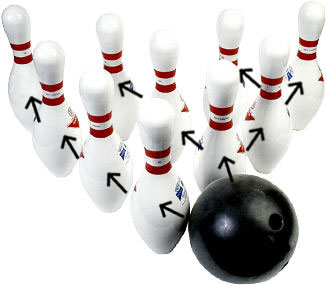
background source: http://www.bluebomber.com/japan/
| Introduction | Potential Energy | Direction of Initial Force | Direction of Impact | Pin Action | Sources |
Pin Action
"Pin action", a.k.a. "pins erupting into chaos", is caused by elastic collisions. Once the bowling ball hits some pins, it sends those pins into more pins, those pins into more pins, and so on. But it doesn't stop there! The pins also bounce off one another, sending them in every conceivable direction (sometimes right back the direction the ball came!) until they've all fallen down, disappeared, or run out of kinetic energy. Because of this kinetic insanity, strikes are almost as unique as snow flakes (but twice as pretty). Each interaction between two or more pins and/or the ball is an elastic collision. The pins bounce against one another because their momentum is conserved during the collision(s).
To achieve the most pin action, the bowler must put plenty of energy into the system and also find a direction of impact to efficiently distribute the kinetic energy. During pin action, some of the energy is transformed into sound. If the bowler's throw produces a single, loud *dink* sound, they are hearing the audible period punctuating their failure of a throw. On the other hand, if the bowler's throw produces a sound not unlike a marble statue being clubbed to death, this means two things. First, there must be lots of pin action to be producing all of those collision sounds; second, the bowler is very strong, has thrown the ball parallel to the horizon, and has hit the pins at an angle capable of distributing the kinetic energy efficiently.

source: http://www.evancfa.org/
(1/2)m1v1i2 = (1/2)m1v1f2 + (1/2)m2v2f2
m1 = mass of the bowling ball or pin
v1i = velocity of ball or pin before collision
v1f = velocity of ball or pin after collision
m2 = mass of pin that was hit
v2f = velocity of pin that was hit
|

